Acne on the face or various parts of the body is often a consequence of internal disorders that arise due to errors in lifestyle, exposure to adverse factors or developing diseases. One of these problems is subcutaneous formations, which are not just an unpleasant aesthetic defect, but also a possible symptom of pathological processes occurring in the body.
What are subcutaneous acne
The process of formation of subcutaneous skin is directly related to the excessive production of sebum, which accumulates in the sebaceous ducts. It is a breeding ground for bacteria that multiply inside the sebaceous glands and provoke subcutaneous inflammation. As a result of the inflammatory process, a hard ball (bump) appears on the skin, which hurts when pressed and, unlike skin rashes such as pimples or acne, is not squeezed out in the usual way.

Inflammation affects the inner layers of the skin, and its superficial keratinized layer creates an obstacle to the normal cleaning of the sebaceous ducts. For this reason, it is difficult to get rid of subcutaneous acne, whether it is small white rashes or one large inflamed subcutaneous area. Such formations are located in the deep layers of the skin and “ripe” for a very long time, and therefore it is impossible to remove accumulations of sebum and pus from them using conventional methods.
Reasons for appearance
Having understood what subcutaneous acne is and what is the mechanism of its formation, it is necessary to find out what causes it. The main reason for the appearance of such rashes is a disruption in the process of sebum secretion, and it develops under the influence of a number of internal pathologies or external adverse influences. Why do subcutaneous lesions appear? Experts name the following factors that contribute to or provoke their formation:
- improper or insufficient skin care;
- hormonal imbalance associated with puberty, pregnancy, contraceptives, or endocrine diseases;
- overheating or hypothermia of the body;
- poor nutrition;
- abuse of peeling or tanning;
- disturbances in the gastrointestinal tract;
- reduced immunity;
- metabolic disease;
- hereditary predisposition;
- gynecological diseases;
- subcutaneous mite;
- bad habits (tobacco use, alcohol use).
On the face
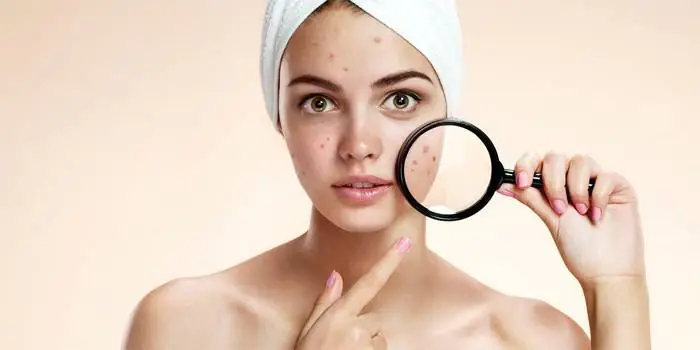
Problems with facial skin, manifested in the form of subcutaneous acne, often indicate hormonal imbalances in the body:
- If small bumps appear on the face that do not go away for a long time, this may be a consequence of developing endocrine pathologies or temporary hormonal imbalance due to natural causes (adolescence, pregnancy).
- In women, white pimples on the face can occur due to ovarian dysfunction caused by polycystic disease. In this case, they are localized on the chin and on the lower cheeks.
- In people with oily or thick skin, internal acne on the face appears due to excessive sebum production and can be located anywhere - on the forehead, nose, cheekbones, chin.
- Painful lumps on the lips that initially look like pimples may be a sign of herpes.
On the back
The appearance of subcutaneous lesions on the back can also be a consequence of sudden hormonal changes, but this phenomenon is often observed in athletes or people leading an active lifestyle. During physical activity, the back constantly sweats, and this contributes to the contamination of the sebaceous ducts and the accumulation of sebum in them, leading to the development of the inflammatory process and the appearance of acne. Find out how to remove acne on a woman's back.
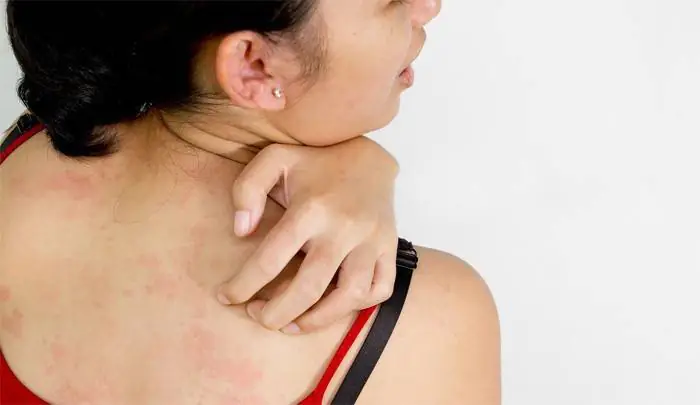
On the neck
Rashes on the neck, located in the deep layers of the epidermis, rarely occur, since the skin in this part of the body is thin. If such pimples appear in this area, it is recommended to undergo a comprehensive medical examination, since they may be associated with diseases of the internal organs or the beginning of the development of pathological processes in the body.
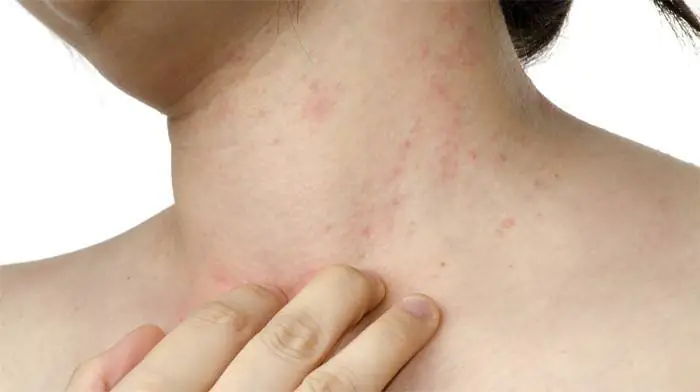
On hands
The appearance of subcutaneous rashes on the hands may indicate endocrine disorders, allergies, and hereditary diseases. If acne appears below the elbow or in the area of the hands, this should be especially alarming, because in these areas there are fewer sebaceous glands and the appearance of skin formations on them can indicate serious pathologies and malfunctions of the body.
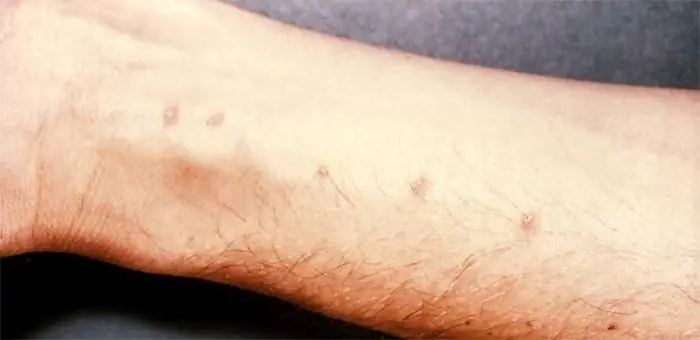
On the labia
Subcutaneous formations in the genital area in many cases occur due to hypothermia of the body. They may appear after a cold, swimming in cold water or improper hardening. Other possible causes are microtraumas that occur during hair removal in the bikini area, as well as wearing synthetic underwear, which irritates the skin and causes it to overheat.
Subcutaneous bumps all over the body
If subcutaneous rashes are located throughout the body, this may be a manifestation of a genetic disease - hereditary lipomatosis. With this disease, bumps can appear on any part of the body - neck, arms, legs, stomach, back. This disorder requires careful examination and long-term complex therapy, and sometimes surgical intervention.
How to get rid of internal pimple
If there are a lot of subcutaneous formations and they do not go away for a long time, it is unlikely that you will be able to get rid of them on your own. In such cases, consultation with a dermatologist and special therapy are necessary. The same applies to such an unpleasant manifestation as acne on the face located deep under the skin, the treatment of which must be carried out under the supervision of a specialist.
However, if the pimple is single and has appeared recently, you can try to remove it without seeking medical help by using available pharmacy and home remedies. How to remove the subcutaneous tissue? Such pimples “mature” for a long time, over several weeks, so attempts to squeeze them out will be unsuccessful. How to treat the skin to speed up this process and prevent complications from developing?
Ointment
An excellent remedy for combating subcutaneous skin are Vishnevsky ointment, Levomekol, and zinc ointment. How to pull out a pimple using these drugs? Ointments should be applied to the affected areas at least 2 times a day. In addition, compresses made from ichthyol ointment have a good effect, drawing the contents of the subcutaneous tissue out. It is recommended to apply them at night.
Cream for subcutaneous acne
When treating subcutaneous rashes, creams with an antibacterial and healing effect are helpful, allowing you to quickly stop the inflammatory process and accelerate tissue regeneration in the affected area. The most effective products in this category, recommended for the fight against subcutaneous skin, are the creams “Baziron”, “Differin”, “Skinoren”, “Klenzit-S”.
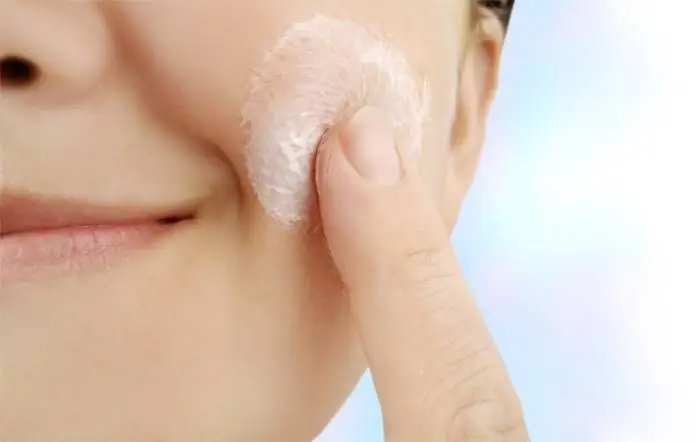
Treatment with folk remedies
Simple folk recipes that are available for use at home will help eliminate subcutaneous formations:
- Aloe compress. It helps well to get rid of such an unpleasant phenomenon as a long-lasting purulent pimple that cannot burst on its own. Cut an aloe leaf, apply it to the site of inflammation and secure with a bandage. It is most convenient to apply the compress at night.
- Tea tree oil. Apply it to your pimples every 3-4 hours for a few days until you notice improvement.
- Mask of oil and garlic. Lubricate the problem area with vegetable oil, and then precisely apply chopped garlic to the area of inflammation and place gauze soaked in hot water over it. Leave on for 20 minutes and rinse off.
How to squeeze a pimple
When deciding to squeeze out a pimple located deep under the skin, it is very important to remember the high risk of infection, even wider spread of rashes or scarring on the skin. A fully mature pimple can be squeezed out after first disinfecting your hands and treating the wound with an antibacterial solution. However, the removal of multiple formations must be entrusted to a dermatologist or cosmetologist.
Video: how to cure an internal pimple
Once and for all, special video materials will help you deal with the problem of subcutaneous rashes, in which this topic is covered in as much detail as possible. Experts talk about the main reasons for the appearance of such formations, provide photos of common types of rashes, explain how to deal with them and how to properly remove a pimple located in the deep layers of the epidermis.
Subcutaneous acne on the face causes a lot of inconvenience and discomfort in aesthetic terms. But you should worry not only about this, because they are a consequence of the inflammatory process that has arisen in the sebaceous glands against the background of purulent concentration in the subcutaneous tissues (or exudate). Such conditions are an excellent environment for the intensive proliferation of bacteria. In serious cases, this process is accompanied by cystic formations.
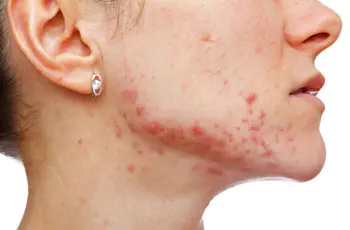
Causes and mechanism of formation of internal pimple on the face.
Subcutaneous acne is not only a problem for young people (about 80%), they can also appear in adults (40%). The main reason for the appearance of subcutaneous acne is the inflammatory process in the sebaceous ducts, which are located deep in the skin. This is due to an increase in the level of androgens (male sex hormones) in the body, as a result of which there is excessive production of sebum, which, in turn, accumulates in the excretory sebaceous ducts and attracts bacteria that feed on this sebum and multiply intensively. Against this background, inflammation develops. The keratinized layer of epithelium or dead surface skin cells clog the outlet of the sebaceous glands, and continued inflammation and infection of the affected area leads to the appearance of a reddish, hard-to-touch lump, which we call a subcutaneous pimple. Other factors can provoke inflammation of the ducts of the sebaceous glands and, as a result, the occurrence of subcutaneous acne.
Factors that provoke the appearance of subcutaneous acne.
- Hormonal imbalance due to puberty, menopause, pregnancy and lactation, taking hormonal contraceptives and medications, the presence of sexually transmitted and neuroendocrine diseases.
- Disorders of the sebaceous glands.
- Dermatological diseases.
- Insufficient or improper skin care.
- Abuse of peelings.
- Unhealthy diet with excess fatty, sugary, sugary foods.
- Violation of cell immunity.
- Genetics.
- Subcutaneous mite (Demodex).
Symptoms and signs of subcutaneous pimple.
The formation of a subcutaneous purulent pustule externally manifests itself in the form of a small hard growth of a reddish or white color, rising above the surface of the skin. As the compaction matures, a bright red tubercle appears, upon pressing which a painful sensation occurs. The size of a red subcutaneous pimple can range from 1-2 mm to 1 cm or more.
Often, with large purulent accumulations, acne growth increases. In advanced cases, large nodes make the skin lumpy with an unhealthy reddish tint. Such formations are localized mainly in areas most susceptible to the development of the inflammatory process (face, chest, back, neck, shoulders, arms).
Red subcutaneous pimples may not form purulent pustules for a long time, accompanied by unpleasant itching and pain when pressed.
If the cause of acne on the face is a subcutaneous mite, then the bright red subcutaneous lumps have multiple distributions and are accompanied by severe itching and flaking of the skin.
The success of treating subcutaneous pimples (acne, acne) depends on the correct identification and elimination of the cause that provoked their appearance.
Consequences for the skin.
Subcutaneous acne affects the external attractiveness of the skin, adding to its owners a lot of complexes about this. In addition, if treated incorrectly, they can leave spots and scars behind (post-acne).
Never squeeze pimples! This leads to the spread of bacteria and acne damage to new areas of the skin, and sometimes blood poisoning, because when squeezed out, the purulent contents directly enter the blood vessels, spreading it throughout the body. By the way, any type of cosmetic skin cleansing is also prohibited, because the procedure itself is nothing more than squeezing out pimples.
Treatment of subcutaneous acne on the face.
Treatment of subcutaneous acne depends on the degree of skin damage. If there are up to 10 such elements on the face (mild degree or first stage), treatment should be exclusively external. In this case, it is necessary to use cosmetics whose action is aimed at reducing sebum, fighting microbes, and eliminating hyperkeratosis. These products include cleansers and mattifying agents (gels, tonics). To treat acne, external gel Differin is effective. Any medications and cosmetics should be selected by a dermatologist and cosmetologist.
The average degree of acne damage to the skin (or the second stage) is when you have from 10 to 40 elements on your face. At this degree of development of acne, internal and external treatment is indicated. External treatment consists of using the same external agents as for mild lesions. But for internal treatment, the doctor individually selects hormonal contraceptives, one of the directions of which is the fight against moderate or moderate acne (pimples or acne). The contraceptive also reduces the level of male sex hormones. Additionally, an antibiotic is prescribed orally (for example, Doxycycline), which should be taken for three months. This is due to the fact that the skin renewal process occurs once every 28 days. Three skin renewals must take place in order for the face to become clean and smooth.
The third degree of skin damage (or third stage) - when there are more than 40 elements on the face, almost the entire face is covered with acne. In this case, the treatment is more serious. The drug retinoic acid (derivatives) is prescribed orally. The only such drug is Roaccutane. There is no external treatment for this degree of skin damage. The drug blocks the release of sebum from the sebaceous glands, depriving microbes of “food”, causing drying of the skin. The drug should be prescribed exclusively by a medical specialist; it gives an effective result.
Methods of treatment and elimination and consequences of acne on the face.
- Microdermabrasion - perfectly removes dead layers of epithelium, increases blood circulation, improves regeneration and recovery processes.
- Acid peeling – cleanses the skin of dead skin cells, accelerates tissue regeneration, and increases skin elasticity.
- Laser resurfacing – removes dead skin cells using a laser beam, the procedure improves tissue metabolism and accelerates their recovery.
- Physiotherapeutic and hardware methods for the treatment of subcutaneous acne (applicable only for mild to moderate lesions).
- Phototherapy – accelerates regeneration processes in cells.
- Ozone therapy - eliminates swelling and inflammation, eliminates pathogenic microbes, reduces pain, stimulates the production of collagen and elastin fibers through exposure to oxygen.
- Elos therapy - exposure to inflamed areas with blue light pulses.
- Mesotherapy – elimination of inflammation and restoration of the skin.
Home methods for treating subcutaneous acne on the face (relevant for mild skin lesions).
Before cleansing the skin, it is effective to take steam baths based on infusions or decoctions of chamomile, celandine, calendula, mint, and sage. Herbal decoctions are also good to use for daily washes or lotions (wipe the skin several times a day). To prepare an infusion of herbs, take a tablespoon of the raw material, pour 200 ml of boiling water and leave for half an hour, strain. To prepare the decoction, do everything the same as for the infusion, only the brewed herb should be additionally simmered over low heat for five minutes, then allowed to cool and strain.
Tea tree oil is a powerful natural antibiotic. It can be applied directly to pimples several times a day.
You can apply iodine to single pimples, do it quickly and carefully, literally touch it with a cotton swab. It is important to be careful here, otherwise you may get a skin burn.
Ichthyol ointment (Vishnevsky ointment) perfectly draws purulent exudate out and lubricates pimples.
Synthomycin emulsion mixed with warm boiled water (1:1) serves as a good tonic (wipe twice a day) that accelerates the healing process.
Tar soap has an excellent antibacterial effect; use it instead of cleansers.
Aloe will help speed up the release of pus from a pimple; it is recommended to cut a fresh leaf in half and apply it to the pimples overnight, securing it with a band-aid. In two days the pus will come out.
For mild skin lesions, it is good to lubricate pimples with calendula tincture in alcohol (can be bought at a pharmacy).
Aspirin also relieves inflammation well, improving skin condition. To do this, apply a mixture of aspirin and water to the spots twice a week (crush the tablet into dust and mix with water to form a paste-like mixture). There is no need to rinse off the mixture.
A decoction of birch buds helps reduce inflammation and pain from red internal pimples. For the decoction, you need to brew 10 g of buds with 250 ml of boiling water, put it on the stove over low heat, after five minutes, remove it and, having wrapped it well, let it brew for three hours, strain. Use daily, rubbing the skin, and additionally apply lotions to inflamed areas two to three times a day.
Homemade mask recipes for internal acne.
Anti-acne masks will also help cleanse the skin, reduce inflammation, and dry out acne.
Clay mask.
Ingredients.
Talc powder – 10 g.
Clay powder (white or blue) – 10 g.
Milk at room temperature – 60 ml.
Application.
Combine the ingredients to a homogeneous paste-like mass, which is spread on the skin and left for twenty minutes. Rinse off the mask with room temperature water.
Clay mask with lemon and calendula tincture.
Ingredients.
Cosmetic clay powder – 3 tbsp. l.
Alcohol tincture of calendula – 20 ml.
Lemon juice – 15 ml.
Application.
Dilute the clay with tincture, add lemon juice. Distribute the composition onto the affected areas and leave for about twenty minutes. Rinse off with water at room temperature.
Clay mask with yeast.
Ingredients.
Cosmetic white clay powder – 10 g.
Yeast in granules - 10 g.
Warm milk.
Honey – ½ tsp.
Application.
Combine the dry ingredients and add milk so that a mass is formed that resembles thin sour cream, into which then pour liquid honey (if there is no individual intolerance). Spread the mixture onto the skin and leave for twenty minutes. Wash off the mask with warm water.
Prevention of subcutaneous acne.
To speed up the treatment process, as well as to prevent the appearance of acne, it is necessary to lead a healthy lifestyle, eat a healthy and balanced diet, eliminate bad habits, including nutrition, take walks in the fresh air, and play sports.
Periodically use herbal infusions (chamomile, calendula, celandine, etc.) to cleanse and tone the skin.
During the treatment of subcutaneous acne, it is recommended to refrain from using decorative cosmetics, especially foundation and dense powder, they clog the pores, preventing the outflow of sebum. For excessively oily skin prone to rashes, these products are generally contraindicated.
There is no self-medication; all medications and drugs should be prescribed and selected only by a doctor.
Red subcutaneous pimples are a very unpleasant type of inflammatory skin changes. Their pathogenesis is always based on several reasons - one factor cannot lead to the appearance of acne.
It follows from this that an integrated approach is required to eliminate and prevent them. One-time measures that eliminate only one cause will help improve the appearance, but will not get rid of the problem for a long time.
Where do they come from?
The mechanism for the appearance of skin defects consists of two main components - disruption of the sebaceous glands and the addition of infection.
The sebaceous glands produce sebum, a substance that is necessary to soften the skin and give it elasticity. If it is produced in excess, the ducts of the sebaceous glands become clogged.
Sometimes this happens very close to the beginning of the duct, and then the “plug” is under the skin - a white subcutaneous pimple is formed. It is painless and does not cause any sensations other than an unpleasant appearance.
An infection can get into the blocked duct, and then the next stage of the disease begins - a red subcutaneous pimple.
This is an inflammation in which normal skin microflora takes part. A red pimple is painful when touched and may itch; the skin around it is healthy or red.
Reasons that lead to the above phenomena:
- hormonal pathologies;
- imbalance of normal microflora;
- poor nutrition;
- violation of personal hygiene rules;
- decreased immunity.
Video: Useful information
How do they look?
The earliest stage of diagnosing acne is carried out by the patient independently. To do this you need to look in the mirror. Negative changes will be visible immediately.
Red subcutaneous acne is characterized by a number of appearance features:
- relatively small size, especially in the early stages;
- bright red color in the flowering stage;
- pain when pressed;
- multiple lesions are possible, with the skin acquiring an unhealthy reddish color and lumpy appearance;
- may be accompanied by itching, peeling of the skin;
- if similar pimples appear on the face, they can spread to other areas of the body - neck, shoulders, torso;
- inability to squeeze out due to too deep location.
Often, several sebaceous glands are affected simultaneously. Multiple lesions look unattractive, are difficult to disguise with cosmetics and do not respond well to the usual home remedies - squeezing and treatment with antiseptics. To completely get rid of them, you need to consult a dermatologist.
How are red subcutaneous pimples diagnosed?
If such formations appear on the face, you need to consult a dermatologist. There is usually no urgent need for this, but acne is very unpleasant and does not go away on its own, so it is important to see a doctor. The specialist begins the diagnostic process with a detailed conversation.
He may ask the patient the following questions:
- about the features of skin care and hygiene;
- about the duration of the disease;
- types of cosmetics used by the patient;
- allergies and intolerances;
- nutritional characteristics;
- about chronic diseases of the gastrointestinal tract, endocrine system, immune system;
- frequency of colds;
- other inflammatory processes on the skin;
- bad habits.
All this can give a hint where to look for the cause of acne. Detailed and truthful answers will save the doctor and patient from the need for a lengthy diagnostic search and help reduce the number of necessary tests.
Laboratory methods require general and biochemical blood tests - they will show possible disorders of the gastrointestinal tract, liver and kidneys that could affect the condition of the skin.
You may also need a blood test for hormones - sex hormones, corticosteroids, thyroid hormones. These three groups most often cause deviations in appearance.
It is quite difficult to determine the type of pathogen - the pimple is located under the skin, and it is not possible to take a smear directly from it.
The doctor takes material for bacteriological analysis from the area of skin closest to the pimple. This method is necessary in order to identify the pathogen and determine which drug will be most effective in this case.
How to fight?
Eliminating acne requires a comprehensive approach. Both medicinal methods and recommendations for proper skin care and lifestyle changes are used.
Only a full impact on the body can completely lead the skin to a healthy and beautiful appearance.
If a big pimple on your butt hurts. You need to follow the link.
What to do with your facial skin?
The first thing you should pay attention to is facial care. During treatment (until the acne goes away), the patient needs to completely abandon decorative cosmetics in the area of inflammation.
Foundation, powder and other products do not always mask skin imperfections; moreover, they interfere with the effective cleansing of the ducts of the sebaceous glands, and acne will last longer.
Instead of decorative cosmetics, you should pay more attention to care products. You need to wash your face twice a day – in the morning and in the evening, and also every time after going outside or doing any dirty work.
In this case, you need to use not soap, but special gels and foams for washing. It is advisable to choose those that are designed to care for problem skin or fight acne.
You can use decoctions and infusions of medicinal herbs for washing. After washing, the skin is treated with miramistin or chlorhexidine.
Be sure to use nourishing or moisturizing creams daily. They are applied before bed, half an hour before going outside, 20 minutes after washing.
Once every 2-3 days you need to use cleansing facial scrubs - they will remove deep impurities, which are the main cause of acne. After using the scrub, you need to lubricate your face with moisturizer.
What to do with your lifestyle?
It is impossible to completely eliminate harmful factors. However, it is possible and necessary to reduce their impact on the body. First of all, this requires paying attention to nutrition.
You should limit your fat intake. Primarily of animal origin. Vegetable oils, on the contrary, will be useful - they contain vitamins A and E, which are necessary for the skin.
It is advisable to replace sweets with honey and fruits - this is much healthier for the skin. In addition, you should eat more well-digestible foods - dairy products, dietary meat and fish. Eggs are not on this list because their effect on the body is ambiguous.
Do I need to take medications?
If the causes of acne are chronic diseases, pathologies of the skin, immune, endocrine or digestive system, then they should be treated with medication. To prescribe medications, you need to consult a specialized specialist.
To treat acne itself, several groups of drugs are prescribed:
- intestinal sorbents and enzyme preparations improve the absorption of nutrients and reduce the amount of toxins entering the blood;
- anti-inflammatory drugs;
- vitamin preparations to correct the functioning of the sebaceous glands;
- hormonal medications to normalize hormonal levels;
- antibiotics to fight bacteria.
What can't you do?
Acne is not a dangerous disease, however, there are a number of things that are not recommended to be done - it is dangerous for the patient’s health.
- Squeezing pimples is ineffective and can cause additional infection. Lead to the spread of the inflammatory process;
- use skin antiseptics with a drying effect (alcohol, peroxide, potassium permanganate) - this will lead to even greater dysfunction of the sebaceous glands and deterioration of appearance;
- use foundation and powder - this reduces the effectiveness of treatment;
- apply burning and irritating substances to the skin - they do not cure acne, but can cause a severe inflammatory reaction;
- ignore doctor's recommendations.
These prohibitions are not difficult to implement, but will allow you to avoid complications of acne - scars, bumps on the skin, spread of the inflammatory process to neighboring tissues, boils and phlegmon.



